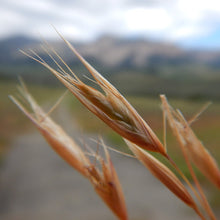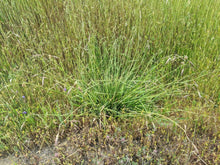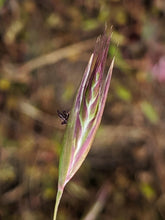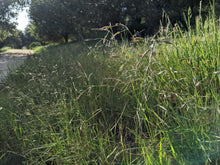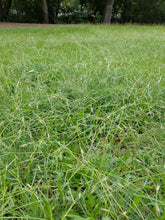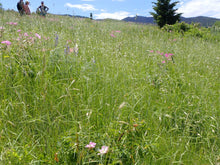
Danthonia californica
California oatgrass is a perennial, semi-evergreen bunchgrass with deep fibrous roots that allow it to thrive in a wide variety of conditions, while stabilizing soils. It forms dense clumps that add a soft touch to natural gardens. In spring, it emerges as a graceful tuft of bright green foliage, accompanied by delicate, arching seed heads that catch the light. By summer and fall, the plant matures into a golden-brown hue, with its feathery seed heads turning a rich amber as they sway in the breeze, creating a textured contrast to the surrounding landscape. As a habitat plant, it plays a vital role in supporting local wildlife, offering shelter and nesting habitat for insects, forage for herbivores and seeds for songbirds.
- Plant type/canopy layer: semi-evergreen, perennial, herbaceous plant
- Size at maturity: 0-36”tall; 12-24” wide
- Light requirements: full sun, part sun/part shade, even full shade though it's not ideal
- Moisture requirements: dry, moist or seasonally wet soil, prefers well-drained
- Bloom time: May-July
- Growth rate/ease: slow to moderate growth rate, easy to grow
- Wildlife support: flowers attract and support bees and other insect pollinators; seeds are eaten by birds and small mammals; overall plant attracts and supports beneficial and pest eating insects and is a caterpillar host plant and larval food source for native butterflies and mots, including several species of skipper butterflies
- Native habitat/range: can be found growing in a wide variety of habitat types including dry grasslands, open woodlands, coastal prairies and moist meadows from British Columbia to southern California, east to Montana and Saskatchewan and south through the Rocky Mountains to New Mexico and Arizona. Portland Plant List; yes.
- Special features & uses: ground cover; deer resistant; landscape uses include erosion control, soil stabilization, as a lawn alternative and in pollinator gardens, rock gardens and meadowscapes; high fire resistance rating, can be planted as a firebreak
Gardening with California Oatgrass: This hardy, yet slow-growing plant will be both forgiving and multi-faceted in your native landscape. It forms clumps of narrow, textured foliage that gracefully complements other native plants, while its dense roots provide exceptional erosion control. It can tolerate a wide range of light and moisture conditions - even dry shade - but it ultimately prefers at least half day sun and moist to dry, well-drained rocky to sandy soil. Giving it at least a few, deep waterings in the peak summer months will keep it looking nicer, longer. Try it as part of a native meadowscape, between paver stones and/or as one component of an eco-lawn alternative, since it would tolerate being occasionally mowed and moderate foot traffic. In the spring and summer months, its flowers and golden seed heads attract a variety of pollinators and birds, adding life and movement to the garden.
Photo Credits 1 & 6 (prairie, with companions, dried seed heads): © Matt Lavin, some rights reserved (CC-BY)
Photo Credits 2-4 (roadside, seed head, habit): © Ken-ichi Ueda, some rights reserved (CC-BY)
Photo Credit 5 (prairie): © D Defreese, some rights reserved (CC-BY)






